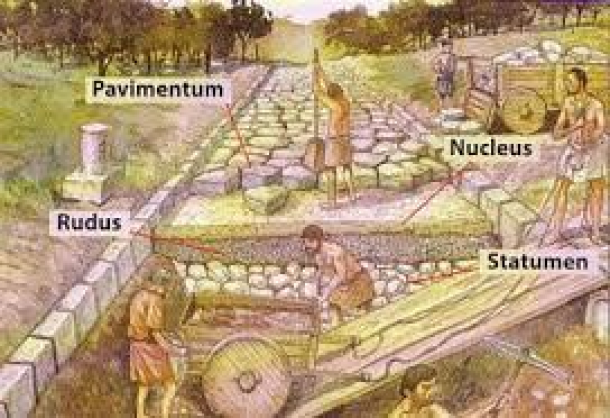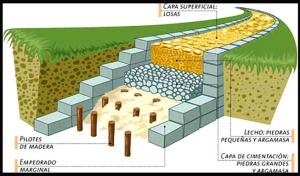The Roman roads... The paths through history
All roads lead to Rome. And it is not a casual saying. The ancient Romans developed a road network throughout their empire that connected Rome, the capital, with the rest of its Empire points.
The paths, roads and routes are a manifestation of the way in which human groups organize the social space from the geographical one; they are part of the production grounded in the design and cultural planning, and are true means for exchange.
For hundreds of years and given the growing needs of humanity to relate and exchange products, the construction of communication roads has been one of the first signs of advanced civilization.
Indeed, as towns and cities of the first cultures developed as demographic, political, economic and cultural centers, they demanded solid and fluid networks of link with other regions, decisive factors for the progress of engineering and to promote the construction of roads and roads connecting distant points of the known world in each historical period.
Antiquity
It is thought that the first roads were implanted from the passage of animals, although this is in doubt because animals usually do not always travel the same roads. The Way of Icknield is an example of this type of origin where humans and animals followed the same path. These roads are called paths of desire.
The wheel was one of the inventions that undoubtedly revolutionized the world of transport in ancient times, probably invented by the peoples of Mesopotamia, approximately in the third millennium BC. These towns saw the need to trade a large number of products and transport them. For the transport came the cart with wheels.
In the third millennium BC, the civilizations of Egypt, Mesopotamia and the Indus Valley built roads, first for the use of their cargo animals and later for the transit of wheeled vehicles. While the Egyptian roads were probably of a funerary nature, those of Mesopotamia had a marked commercial character. From the 6th century BC the Persians began to join existing roads to form the "Camino Real" from Ephesus to Susa, which had more than 2,500 km. of length. In turn, the Silk Road was built in China and a system of paths and roads was developed around the eleventh century BC. Already in the 3rd century BC a.n.e. In the Ch'in dynasty a wide network of roads was built throughout the country.

The Roman roads
The road network was developed with an eminently practical and military purpose because it aimed to allow the legions a good road through which to march as quickly and comfortably as possible. It was such an engineering development and economic investment that they carried out, that many of these roads were the best and were used in many parts of Europe until the nineteenth century.
Its rapid development changed the vision of the world known by the Roman culture. The use of the roads promoted trade and contacts between peoples who had never heard of each other and communications allowed the development of ideas and, of course, the expansion of Roman culture.
The Romans were famous for building -from 312 BC- a wide network of roads, the famous Roman roads, which allowed them to govern their immense empire, without which it would have been impossible, since their supremacy was developed from a city -state (Rome) that was invading other small bordering states, building roads that linked the occupied regions to help consolidate their conquests. This network of roads linked Europe and North Africa through 29 major arteries in a system that will cover 78,000 kilometers.
Initially, this system of roads was designed for military and political purposes, since the main objective of its construction was to maintain effective control of the areas incorporated into the Empire; later, the roads acquired an added economic importance, since when uniting different regions they facilitated the commerce and the communications, that is the predominant function of the present roads, therefore they connect zones and irradiate new productive sectors to the market. Simultaneously and as a demonstration of their advances in engineering, the Romans built famous bridges over the rivers that cut the path of their roads.
An important reason why Roman roads were so durable, is the care they put into the design and execution of a convenient drainage system, which primarily consisted of excavating ditches at the ends of the road and parallel to it.
The type section of a Roman road was composed of the following layers, in descending order of depth: A foundation of flat stones or statumen. A layer formed by quarries and quarry detritus, called rudus. An intermediate layer of concrete based on crushed stone and fatty lime, called nucleus. A finishing layer, formed by a stone pavement sealed with lime mortar, called summum dorsum. The Latin term for this cover was pavimentum, which today is known as pavement. This pavement was accompanied by the limits of the road, two parallel curbs formed by blocks of large stones and carved.

How Roman roads were built
The Roman roads stood out for their straightness that shortened the road between villages, cutting hills and streams, saved by stone bridges. The Romans referred to these works as munire viam (build a wall). And that was really what they were building. A wall about 5 meters wide and one meter high.
Thanks to the writer Vitruvio we know the construction process that consisted of the following:
First a ditch with a sufficient width was excavated so that a large car could pass without problems, and a sufficient depth to introduce the different types of filling according to the ground.
The lower floor was leveled and tamped with wooden blocks and later filled with statues, small stones. The amount of these stones depended on the porosity of the soil.
On the statum was placed the rudus, a kind of gravel made with pieces of stone and mud and about 20 centimeters thick.
Above this was placed the nucleus, composed of crushed stone and lime.
Finally, the pavement was placed with blocks of hard stones with mortar to avoid fissures and water colliding or causing knocks with the wheels. They had a rounded surface to evacuate the water and prevent it from accumulating in the center of the road.
I really liked how you talked about how the first streets of the world were created